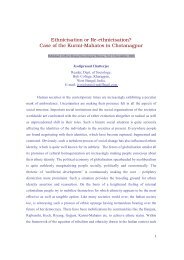RM360 RM460 RM660 RM760 Service Manual - WebRing Inc.
RM360 RM460 RM660 RM760 Service Manual - WebRing Inc.
RM360 RM460 RM660 RM760 Service Manual - WebRing Inc.
You also want an ePaper? Increase the reach of your titles
YUMPU automatically turns print PDFs into web optimized ePapers that Google loves.
INSTRUCTIONS FOR USE<br />
INSTALLATION OF THE REFRIGERATOR IN A VEHICLE<br />
The refrigerator must be installed on a solid<br />
floor and must be level. With the vehicle carefully<br />
leveled the refrigerator should level both<br />
ways in the freezer compartment.<br />
Free air circulation over the fins of the cooling<br />
unit is essential. Clearances around the refrigerator<br />
should be in accordance with the label<br />
attached to the rear plate of the refrigerator.<br />
In case detailed instructions on the installation<br />
and connection to the gas supply are required,<br />
contact your dealer or distributor.<br />
Leveling<br />
In the boiler ammonia vapor is distilled from an<br />
ammonia-water mixture and carried to the finned<br />
condenser, where it liquifies. The liquid flows<br />
to the evaporator, where it creates cold by<br />
evaporating into a circulating flow of hydrogen<br />
gas. If the evaporator coil is not level the<br />
liquid readily accumulates, forming pockets<br />
which can impair the gas circulation or even<br />
block it, in which case, of course, the cooling<br />
will stop.<br />
When the recreational vehicle is stationary it<br />
must be leveled to be comfortable to live in. If<br />
the refrigerator is properly installed, i e the<br />
freezer shelf parallel to the floor, the refrigerator<br />
will then also perform well.<br />
A bubble level should be placed on the freezer<br />
shelf. When the vehicle is on tow, the continuous<br />
rolling and pitching movement will not affect<br />
the refrigerator as long as the movement passes<br />
either side of level, but when the trailer is<br />
temporarily parked this sensitivity of the refrigerator<br />
should be remembered. So, once more,<br />
before you start the refrigerator, make sure<br />
it is level.<br />
HOW TO START THE REFRIGERATOR.<br />
Gas Operation(Fig. 7)<br />
1. To start<br />
position<br />
2. Turn the<br />
3. Push the<br />
D of the<br />
repeated<br />
This can<br />
Fig.7<br />
4. After the gas is lit keep the button C pushed<br />
for 10 seconds. Release the button and check<br />
through the reflector that the burner flame<br />
stays burning. If not repeat the lighting procedure.<br />
NOTE: After a replacement of the gas container<br />
or a long shut off period the gas<br />
line is likely to be filled with air. In<br />
such a case the lighting procedure has<br />
to be repeated until the air is pushed<br />
out of the line and the gas has reached<br />
the burner.<br />
Flame Blow Out<br />
If trouble is encountered with the flame blowing<br />
out under specially windy conditions, try to<br />
avoid the wind blowing against the wall where<br />
vent outlets are located. If the trouble persists,<br />
set the thermostat to MAX. This later measure<br />
can of course only be temporary such as when the<br />
vehicle is on tow, for after a day or so at this<br />
setting the foodstuffs in the cabinet will freeze.<br />
Electric Operation (Fig. 7)<br />
1.<br />
2.<br />
3.<br />
Check that the attachment plug is correctly<br />
connected to the mains supply. When the refrigerator<br />
is equipped also for 12 Volts D C<br />
operation the low voltage connection is made<br />
at the marked terminals at the rear of the refrigerator.<br />
Turn the knob A to desired position for electric<br />
operation.<br />
Turn the thermostat knob B to setting 4.<br />
HOW TO USE THE REFRIGERATOR<br />
Food Storage Compartment<br />
The food storage compartment is completely closed<br />
and unventilated, which is necessary to maintain<br />
the required low temperature for food storage.<br />
Consequently foods having a strong odor or liable<br />
to absorb odors should be covered. Vegetables,<br />
salads etc. should be covered to retain their<br />
crispness. The coldest positions in the refrigerators<br />
are underneath the cooling evaporator and<br />
at the bottom of the refrigerator, and the least<br />
cold positions are on the upper door shelves. This<br />
should be considered when different types of food<br />
are placed in the refrigerator.<br />
Frozen Food Storage Compartment<br />
The ice trays should be placed in direct contact<br />
with the freezer shelf for fastest ice making.<br />
Quick frozen soft fruits and ice cream should be<br />
placed in the coldest part of the compartment,<br />
the refrigerator turn the knob A to<br />
which is at the bottom of the aluminum liner or,<br />
in models with a shelf, on this or just below it.<br />
"GAS".<br />
Frozen vegetables, on the other hand, may be<br />
thermostat knob B to setting 4.<br />
button C to stop and push the button<br />
piezo igniter. The pushing has to be<br />
until the gas is lit at the burner.<br />
stored in any part of the compartment.<br />
The compartment is not designed for the deep or<br />
quick freezing of foodstuffs. Meat or fish foods,<br />
whether raw or prepared, and provided they are<br />
be observed through the reflector E. precooled in the refrigerator, can however, also<br />
6

















